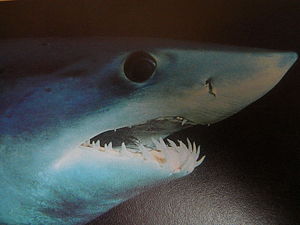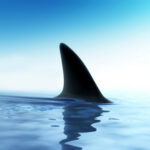Being an avid traveler, snorkeler, and beach-goer makes knowing and hearing about shark attacks common. While traveling in Australia, I was fortunate enough to live through a shark attack at a beach in New South Wales. However, the shark I was bitten by was a young Grey Nurse Shark, which left minimal wounds in my lower leg. A local New South Wales that aided me through the minor bite told me about his own tale of being attacked by a Shortfin mako shark, and barely surviving to tell about what happened.
The local, only known as Aussie Cliff, was out surfing at a close by beach early in the morning. The waves were strong and soon enough he and his surfboard had drifted out a good half mile from the shore. Although any Australian knows not to surf from dusk to dawn, Cliff insisted that the waves were perfect and tourists were no place in sight. As he dove under a weak wave, he suddenly felt and saw a group of fight quick rush past him. Before he could even think, a larger creature headed toward him. He knew it was a shark. Quickly, he paddled up to the shore, since he knew the Shortfin mako shark tends to hunt in more murky waters where catching prey is easier.
Before he could reach the surface, the shark’s sharp teeth dug into his forearm, pulling away a significant amount of flesh. Cliff proceeded to kick the shark, pushing it away from him, allowing him to swim up to the surface. The shark quickly swam away further out to sea. He was not worried about his wound, what he was more worried about was the blood, which could potentially attract other predators, including more sharks. Keeping his injured arm above the surface, he paddled back to shore where he was able to call for help.
Upon arriving to the hospital, shark tooth fragments were extracted from his arm, confirming that the shark that bit him was indeed a Shortfin mako shark. Due to the speed and aggression of the shark, he was able to survive the incident. In fact, Mako sharks have known to swim up to speeds of 30 miles per hour and have sharp, almost needle like teeth. Cliff was able to walk away with only a critical arm wound, though much more severe than my shark injury.
What many people don’t realize is that shark attacks are extremely easy to avoid, even though hundreds of shark attacks happen each year. Here are some tips to help prevent any encounters with these deadly creatures:
1) You should never swim after between dusk at dawn. Many beaches forbid access during these times out of safety and you should always be aware of local precautions taken to protect your safety. When it is dark out, it impairs your sight and makes you an easy target for attacks.
2) Never swim by yourself and always watch children in the water. Safety is in numbers, especially since sharks prefer lone prey because they are extremely easy targets.
3) Swim in open water where nothing can obscure your vision. Predators are more likely to hide near reefs, channels, and other parts of the water that are obscured.
4) Be aware of any cuts or wounds. Sharks have a great sense of smell that allows them to detect blood in the water. If you cut yourself, leave the water. It will ensure your safety and the safety of those around you.



